Stylistic differences
In popular music, the metre is most often quadruple, [1] but this does not mean that triple metre does not appear. It features in a good amount of music by artists such as The Chipmunks, Louis Armstrong or Bob Dylan. [2]
In jazz, this and other more adventurous metres have become more common since Dave Brubeck's album Time Out . [3] [4] [5] One noteworthy example of a jazz classic that employs triple metre is John Coltrane's version of "My Favorite Things". [6]
Triple time is common in formal dance styles, for example the sarabande, the minuet, the mazurka, the waltz and others.
Triple metre is rare in national anthems – the national anthems of Austria, the United Kingdom, Switzerland, Greece, and the United States being notable exceptions.

David Warren Brubeck was an American jazz pianist and composer. Often regarded as a foremost exponent of cool jazz, Brubeck's work is characterized by unusual time signatures and superimposing contrasting rhythms, meters, and tonalities.
A time signature is a convention in Western music notation that specifies how many note values of a particular type are contained in each measure (bar). The time signature indicates the meter of a musical movement.
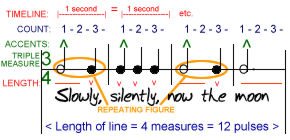
In music, metre or meter refers to regularly recurring patterns and accents such as bars and beats. Unlike rhythm, metric onsets are not necessarily sounded, but are nevertheless implied by the performer and expected by the listener.

Polyrhythm is the simultaneous use of two or more rhythms that are not readily perceived as deriving from one another, or as simple manifestations of the same meter. The rhythmic layers may be the basis of an entire piece of music (cross-rhythm), or a momentary section. Polyrhythms can be distinguished from irrational rhythms, which can occur within the context of a single part; polyrhythms require at least two rhythms to be played concurrently, one of which is typically an irrational rhythm. Concurrently in this context means within the same rhythmic cycle. The underlying pulse, whether explicit or implicit can be considered one of the concurrent rhythms. For example, the son clave is poly-rhythmic because its 3 section suggests a different meter from the pulse of the entire pattern.

In music and music theory, the beat is the basic unit of time, the pulse, of the mensural level. The beat is often defined as the rhythm listeners would tap their toes to when listening to a piece of music, or the numbers a musician counts while performing, though in practice this may be technically incorrect. In popular use, beat can refer to a variety of related concepts, including pulse, tempo, meter, specific rhythms, and groove.

Joseph Albert Morello was an American jazz drummer best known for serving as the drummer for pianist Dave Brubeck, as part of the Dave Brubeck Quartet, from 1957 to 1972, including during the quartet's "classic lineup" from 1958 to 1968, which also included alto saxophonist Paul Desmond and bassist Eugene Wright. Morello's facility for playing unusual time signatures and rhythms enabled that group to record a series of albums that explored them. The most notable of these was the first in the series, the 1959 album Time Out, which contained the hit songs "Take Five" and "Blue Rondo à la Turk". In fact, "Take Five", the album's biggest hit was specifically written by Desmond as a way to showcase Morello's ability to play in 5
4 time.
Duple metre is a musical metre characterized by a primary division of 2 beats to the bar, usually indicated by 2 and multiples (simple) or 6 and multiples (compound) in the upper figure of the time signature, with 2
2, 2
4, and 6
8 being the most common examples.
In music, a tuplet is "any rhythm that involves dividing the beat into a different number of equal subdivisions from that usually permitted by the time-signature " This is indicated by a number, or sometimes two indicating the fraction involved. The notes involved are also often grouped with a bracket or a slur.

In Western musical notation, a dotted note is a note with a small dot written after it. In modern practice, the first dot increases the duration of the basic note by half of its original value. This means that a dotted note is equivalent to writing the basic note tied to a note of half the value – for instance, a dotted half note is equivalent to a half note tied to a quarter note. Subsequent dots add progressively halved value, as shown in the example to the right.

Čoček is a musical genre and dance that emerged in the Balkans during the early 19th century. It features prominently in the repertoire of many Romani brass bands.
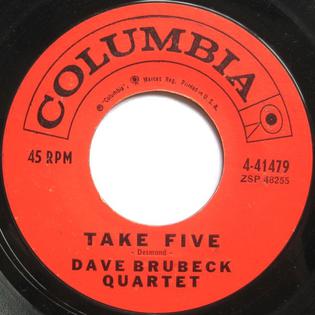
"Take Five" is a jazz standard composed by Paul Desmond. It was first recorded in 1959 and is the third track on Time Out by the Dave Brubeck Quartet. Frequently covered by a variety of artists, the track is the biggest-selling jazz song of all time and a Grammy Hall of Fame inductee.
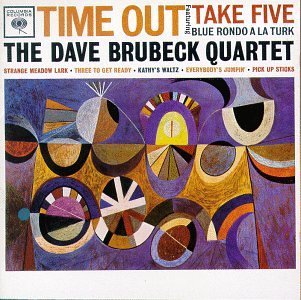
Time Out is a studio album by the American jazz group the Dave Brubeck Quartet, released in 1959 on Columbia Records. Recorded at Columbia's 30th Street Studio in New York City, it is based upon the use of time signatures that were unusual for jazz such as 9
8, 6
4 and 5
4. The album is a subtle blend of cool and West Coast jazz.
Sextuple metre or sextuple time is a musical metre characterized by six beats in a measure. Like the more common duple, triple, and quadruple metres, it may be simple, with each beat divided in half, or compound, with each beat divided into thirds. The most common time signatures for simple sextuple metre are 6
4 and 6
8, and compound sextuple metre is most often written in 18
8 or 18
16. A time signature of 18
8 or 18
16, however, does not necessarily mean that the bar is a sextuple metre with each beat divided into three. It may, for example, be used to indicate a bar of triple metre in which each beat is subdivided into six parts. In this case, the metre is sometimes characterized as "triple sextuple time". Such a division of time may be encountered more frequently in the Baroque period: for example, variation 26 of the Goldberg Variations by Johann Sebastian Bach has 18
16 in one hand against 3
4 in the other, exchanging hands at intervals until the last five bars where both hands are in 18
16. Using 3
4 for both hands would result in continuous sextuplets.

"Unsquare Dance" is a composition by jazz pianist Dave Brubeck that was released as a single in 1961. Included on Brubeck's album Time Further Out, the piece reached No. 93 on the Cash Box chart on December 16, 1961.

In popular music, half-time is a type of meter and tempo that alters the rhythmic feel by essentially doubling the tempo resolution or metric division/level in comparison to common-time. Thus, two measures of 4
4 approximate a single measure of 8
8, while a single measure of 4/4 emulates 2/2. Half-time is not to be confused with alla breve or odd time. Though notes usually get the same value relative to the tempo, the way the beats are divided is altered. While much music typically has a backbeat on quarter note (crotchet) beats two and four, half time would increase the interval between backbeats to double, thus making it hit on beats three and seven, or the third beat of each measure :
1 2 3 4 1 2 3 4 1 2 3 4 5 6 7 8 1 2 3 4
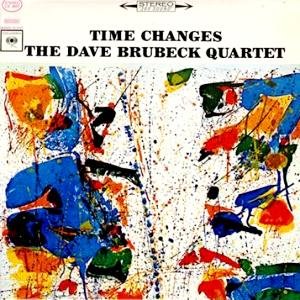
Time Changes is a 1964 album by The Dave Brubeck Quartet, based upon the use of time signatures that were unusual in jazz music.
Quintuple meter or quintuple time is a musical meter characterized by five beats in a measure.
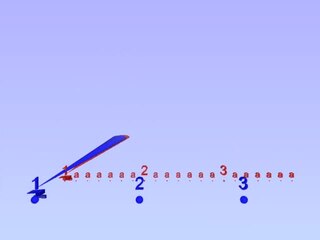
Septuple meter or septuple time is a meter with each bar divided into 7 notes of equal duration, usually 7
4 or 7
8. The stress pattern can be 2+2+3, 3+2+2, or occasionally 2+3+2, although a survey of certain forms of mostly American popular music suggests that 2+2+3 is the most common among these three in these styles.

Countdown—Time in Outer Space is a studio album released by the Dave Brubeck Quartet in 1962 on Columbia LP record CS 8575 (stereo) and CL 1775 (mono). The front cover features the 1959 painting Orange and Black Wall by Franz Kline. In Australia the album appeared on the Coronet label. It was re-released, for the first time in digital format, in 2004 as part of a compact disc collection titled Dave Brubeck: For All Time. It was again released as part of the box set The Dave Brubeck Quartet: the Columbia Studio Albums Collection 1955-1966. Both CD re-releases feature a bonus track titled "Fatha".














